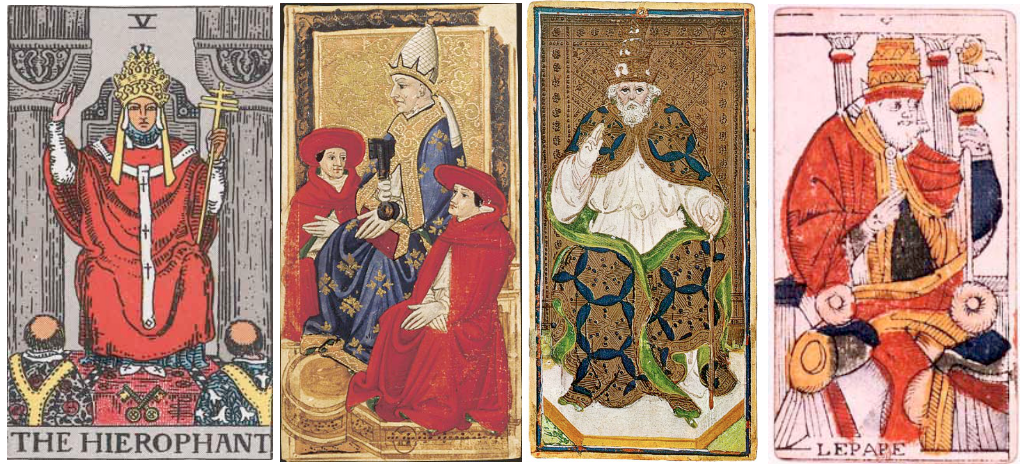The Hierophant
The Hierophant is the fifth card in the Major Arcana in most traditional Tarot decks. It is derived from the historical card known as the Pope in playing card decks.
It is associated with the sefira of Gevurah ("Discipline") on the Kabbalistic Tree of Life.
In astrology, the Hierophant corresponds to the Zodiac sign of Taurus.
Depiction
In many modern decks, the Hierophant is represented with his right hand raised in blessing or benediction, with two fingers pointing skyward and two pointing down, thus forming a bridge between Heaven and Earth reminiscent of that formed by the body of The Hanged Man. The Hierophant is thus a true "pontiff," in that he is the builder of the bridge between deity and humanity. In his left hand he holds a triple cross.
The Hierophant is typically male, even in decks that take a feminist view of the Tarot, such as the Motherpeace Tarot, The Hierophant was also known as "The Teacher of Wisdom."
In most iconographic depictions, the Hierophant is seen seated on a throne between two pillars symbolizing Law and Liberty or obedience and disobedience, according to different interpretations. He wears a triple crown, and the keys to Heaven are at his feet. Sometimes he is shown with worshippers, as his alternate title is the Pope or, sometimes, Jupiter. The card is also known as "The High Priest," as a counterpart to "The High Priestess" (which itself is also sometimes known as "The Papess," as counterpart to "The Pope").
In the Vlad Dracula Tarot, the Hierophant is embodied as Pope Pius II. Instead of reaching to heaven, one hand is pointing toward the earth, to symbolize his temporal power in Europe, and the other hand is pointing to his right, symbolizing his desire to send a military force to repel Ottoman attacks.
History
The papacy was not just a religious force, but was a political and military force as well. When the tarot was invented, the Pope controlled a large portion of central Italy known as the Papal States. Renaissance culture did not question the abstract ideal of the Pope as God's human representative on Earth, but others involved in the religious Reformation of that Age would have disagreed. In the Tarot of Marseilles, he wears a red cape and a blue robe, in contrast to The Papess, who wears a blue cape and blue robe.
In occult circles the more commonly encountered modern name "Hierophant" is due to Antoine Court de Gébelin and was an attempt to dechristianise the standard French tarot pack, the Tarot de Marseilles, out of a mistaken belief of a pre-Christian origin. According to de Gebelin, "hierophant" was the title of the chief priest in the Eleusinian mysteries (an ancient Greek ritual).
Divinatory meaning
In divination, this card usually indicates marriage, alliance, captivity, or servitude. Mercy and goodness, inspiration, a man to whom the Querent has recourse. Holiness and religion.
In reversed position, it means: Society, good understanding, or weakness.
| Tarot Topics | ||
|---|---|---|
| Major Arcana | The Fool • The Magician • The High Priestess • The Empress • The Emperor • The Hierophant • The Lovers • The Chariot • Strength • The Hermit • Wheel of Fortune • Justice • The Hanged Man • Death • Temperance • The Devil • The Tower • The Star • The Moon • The Sun • Judgement • The World | |
| Minor Arcana | Pentacles | Ace • Two • Three • Four • Five • Six • Seven • Eight • Nine • Ten • Page • Knight • Queen • King |
| Wands | Ace • Two • Three • Four • Five • Six • Seven • Eight • Nine • Ten • Page • Knight • Queen • King | |
| Cups | Ace • Two • Three • Four • Five • Six • Seven • Eight • Nine • Ten • Page • Knight • Queen • King | |
| Swords | Ace • Two • Three • Four • Five • Six • Seven • Eight • Nine • Ten • Page • Knight • Queen • King | |
| Decks | Visconti-Sforza Tarot • Tarot of Marseilles • Rider-Waite Tarot • Thoth Tarot • Occult Tarot • Angel Tarot • Vlad Dracula Tarot • Hieronymus Bosch Tarot | |
